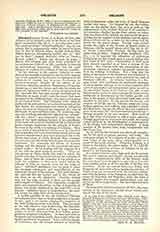

Gelasius of Cyzicus, ecclesiastical writer. He was the son of a priest of Cyzicus, and wrote in Bithynia, about 475, to prove against the Eutychians, that the Nicene Fathers did not teach Monophysitism. These details he gives us in his preface (Labbe, II, 117). Beyond that nothing is known about his personality. His “Syntagma” or collection of Acts of the Nicene Council, has hitherto been looked upon as the work of a sorry compiler; recent investigations, however, point to its being of some importance. It is divided into three books (Labbe, II, 117-296): bk. I treats of the Life of Constantine down to 323; bk. II of History of the Council in thirty-six chapters; of bk. III only fragments have been published. The whole of book III was discovered by Cardinal Mai in the Ambrosian Library, and its contents are fully described by Oehler. The serious study of the sources of Gelasius may be said to have begun with Turner’s identification of the long passages taken from Rufinus (X, 1-5) in bk. II. A complete analysis of the sources [the Hist. Eccl. of Eusebius, Rufinus (in the Greek version of Gelasius of Caesarea d. 395), Socrates, Theodoret, “John”, and Dalmatius], will be found in Loschcke, whose efforts it would appear, have restored to Gelasius a place among serious Church historians, of which he has been wrongly deprived, and have also lent weight to the hitherto generally rejected idea that there was an official record of the Acts of the Council of Nicaea; and further that it was from this record that Dalmatius derived the opening discourse of Constantine, the confession of Hosius, the dialogue with Phaedo, and the nine dogmatic constitutions, which Hefele had pronounced “most certainly spurious”. The “John” to whom Gelasius refers as a forerunner of Theodoret, is still unidentified; from him were derived the published portions of bk. III, the letters of Constantine to Arius, to the Church of Nicomedia, and to Theodotus, all of which Loschcke contends are authentic. He also proves that a comparison of Constantine’s letter to the Synod of Tyre (335), as given by Gelasius and Athanasius (Apolog., n. 86), shows Gelasius to give the original, Athanasius an abbreviated version.
EDWARD MYERS

